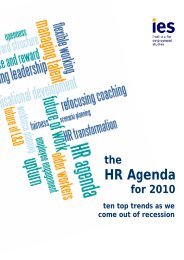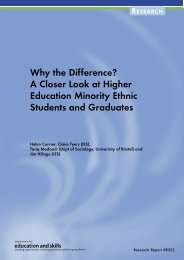Post-16 Transitions: a Longitudinal Study of Young People with ...
Post-16 Transitions: a Longitudinal Study of Young People with ...
Post-16 Transitions: a Longitudinal Study of Young People with ...
You also want an ePaper? Increase the reach of your titles
YUMPU automatically turns print PDFs into web optimized ePapers that Google loves.
10.5.2 Weighting<br />
Table A.3 reports the achieved sample at Wave 2 against estimates<br />
<strong>of</strong> the number <strong>of</strong> Year 11 students in 2000 by school type and<br />
whether they had a statement <strong>of</strong> special educational need. 1<br />
As can be seen below, the number <strong>of</strong> young people in the Wave 2<br />
sample <strong>with</strong>out statements and from mainstream schools are<br />
under-represented, while students <strong>with</strong> statements are overrepresented.<br />
This has been corrected for in the data set through<br />
the use <strong>of</strong> cell based weighting. 2<br />
Table A.3: Estimates <strong>of</strong> the number <strong>of</strong> secondary level students <strong>with</strong> SEN and Wave 1<br />
distributions.<br />
Secondary school non-statemented (levels 2 to<br />
4)<br />
Wave 2<br />
Population<br />
N = % %<br />
593 34 54<br />
Secondary school statemented 638 36 24<br />
Special school statemented 505 29 22<br />
Special school – other 18 1 1<br />
Total 1,756 100 101<br />
Base for Wave 2 excludes cases in which the level <strong>of</strong> SEN was not known.<br />
The following chapters document the findings from the case<br />
studies alongside the data from the quantitative survey. All names<br />
have been changed to protect the identities <strong>of</strong> the young people<br />
who took part.<br />
1 The estimates are based on DfES figures collected from the Annual<br />
School Census. However in 2000, the data was not collected in a way<br />
that makes it possible to know how many were on stages 2 to 4 <strong>of</strong> the<br />
old SEN Code <strong>of</strong> Practice or how many <strong>of</strong> the SEN pupils were in<br />
Year 11. It has therefore been necessary to estimate this based on the<br />
ratio observed <strong>with</strong>in the overall sample from the Wave 2 PIF, which<br />
has been designed to be representative <strong>of</strong> the population.<br />
2 In the 120 cases where data were not available on SEN level,<br />
weighting was based on the school type alone.<br />
<strong>Post</strong>-<strong>16</strong> <strong>Transitions</strong> <strong>of</strong> <strong>Young</strong> <strong>People</strong> <strong>with</strong> SEN: Wave 2 151

















